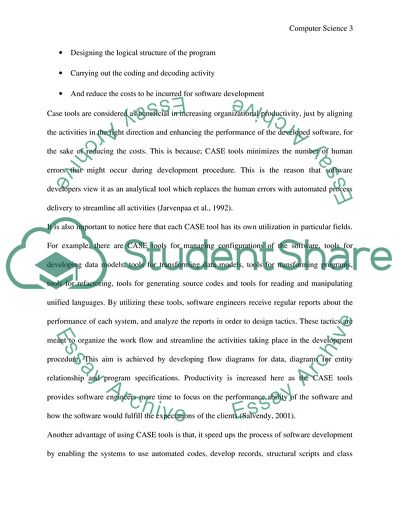Cite this document
(Computer-Aided Software Engineering Tools Coursework Example | Topics and Well Written Essays - 2000 words, n.d.)
Computer-Aided Software Engineering Tools Coursework Example | Topics and Well Written Essays - 2000 words. https://studentshare.org/information-technology/1805844-explain-how-computer-aided-sofware-engineering-case-tools-are-used-to-aid-compaines-to-become-more-productive-analyze-the-nagative-impacts-of-the-usage-of-case-tools-by-the-companies
Computer-Aided Software Engineering Tools Coursework Example | Topics and Well Written Essays - 2000 words. https://studentshare.org/information-technology/1805844-explain-how-computer-aided-sofware-engineering-case-tools-are-used-to-aid-compaines-to-become-more-productive-analyze-the-nagative-impacts-of-the-usage-of-case-tools-by-the-companies
(Computer-Aided Software Engineering Tools Coursework Example | Topics and Well Written Essays - 2000 Words)
Computer-Aided Software Engineering Tools Coursework Example | Topics and Well Written Essays - 2000 Words. https://studentshare.org/information-technology/1805844-explain-how-computer-aided-sofware-engineering-case-tools-are-used-to-aid-compaines-to-become-more-productive-analyze-the-nagative-impacts-of-the-usage-of-case-tools-by-the-companies.
Computer-Aided Software Engineering Tools Coursework Example | Topics and Well Written Essays - 2000 Words. https://studentshare.org/information-technology/1805844-explain-how-computer-aided-sofware-engineering-case-tools-are-used-to-aid-compaines-to-become-more-productive-analyze-the-nagative-impacts-of-the-usage-of-case-tools-by-the-companies.
“Computer-Aided Software Engineering Tools Coursework Example | Topics and Well Written Essays - 2000 Words”. https://studentshare.org/information-technology/1805844-explain-how-computer-aided-sofware-engineering-case-tools-are-used-to-aid-compaines-to-become-more-productive-analyze-the-nagative-impacts-of-the-usage-of-case-tools-by-the-companies.


